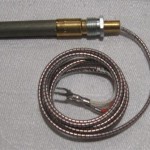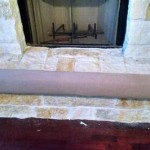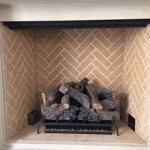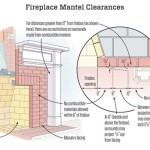Replacing a Metal Fireplace Surround: A Comprehensive Guide
A fireplace serves as a focal point in many homes, offering warmth and aesthetic appeal. The fireplace surround, the decorative framework surrounding the firebox, plays a crucial role in defining the overall style of the fireplace and the room it inhabits. Metal fireplace surrounds, while durable and able to withstand high temperatures, may become outdated, damaged, or simply no longer align with evolving design preferences. Replacing a metal fireplace surround is a project that can significantly enhance the look of a living space. This article provides a detailed overview of the process, considerations, and options involved in replacing a metal fireplace surround.
Assessing the Existing Fireplace and Surround
Before embarking on the replacement process, a thorough assessment of the existing fireplace and surround is essential. This includes identifying the type of metal surround currently in place. Common materials include cast iron, steel, and brass, each possessing unique characteristics and requiring specific handling during removal and disposal. Examination of the surround's condition is also crucial. Note any damage, such as rust, dents, or cracks. Determine the structural integrity of the surround and its attachment points. The method used to secure the surround to the fireplace, whether it be screws, bolts, adhesive, or a combination thereof, directly impacts the removal procedure.
Measuring the existing surround is vital for selecting a suitable replacement. Accurate measurements of the surround's height, width, and depth, as well as the firebox opening, are necessary to ensure a proper fit. Consideration should be given to the clearance requirements specified by the fireplace manufacturer and local building codes. Improperly sized surrounds can pose safety hazards or impede the fireplace's functionality. Documenting all measurements and taking photographs of the existing surround are helpful references throughout the project.
Safety is paramount during the assessment and subsequent replacement process. Ensure the fireplace is completely cool before beginning any work. Disconnect any gas or electrical connections to the fireplace, if applicable, and consult with a qualified professional if unsure. Wear appropriate personal protective equipment (PPE), including safety glasses, gloves, and a dust mask, to protect against potential hazards. A careful and meticulous assessment sets the stage for a smooth and successful replacement.
Removing the Existing Metal Surround
The removal of the existing metal surround requires a systematic approach, prioritizing safety and preventing damage to the fireplace and surrounding area. Begin by protecting the floor and adjacent walls with drop cloths or plastic sheeting. This safeguards against debris, scratches, and other potential damage. If the surround is attached with screws or bolts, carefully loosen and remove them with the appropriate tools. If adhesive is used, a heat gun may be necessary to soften the adhesive and facilitate removal. Apply heat gradually and evenly, being careful not to overheat the surrounding materials.
For surrounds that are particularly difficult to remove, consider using a putty knife or scraper to gently pry the surround away from the fireplace. Work slowly and carefully, avoiding excessive force that could damage the fireplace or the surrounding wall. If the surround is in multiple pieces, remove each piece individually, noting the order in which they were installed. This can be helpful when installing the new surround.
Once the surround is removed, thoroughly clean the fireplace surface to remove any remaining adhesive, dust, or debris. A wire brush or scraper can be used to remove stubborn residue. Inspect the underlying fireplace structure for any damage that may need to be repaired before installing the new surround. Properly dispose of the old metal surround according to local regulations. Metal can often be recycled, so consider taking it to a recycling center.
Installing the New Fireplace Surround
The installation of the new fireplace surround is the culmination of the project. Ensure that the new surround is compatible with the existing fireplace and that it meets all safety requirements. Carefully unpack the new surround and inspect it for any damage that may have occurred during shipping. Read the manufacturer's instructions thoroughly before beginning the installation process. These instructions provide specific guidance on how to properly install the surround and ensure its safe operation.
Position the new surround around the firebox opening, ensuring it is centered and level. Use shims, if necessary, to create a level surface. If the surround is attached with screws or bolts, pre-drill pilot holes to prevent the wood from splitting. Secure the surround to the fireplace using the appropriate fasteners. If adhesive is used, apply a thin, even layer to the back of the surround and press it firmly against the fireplace. Hold the surround in place until the adhesive has set, according to the manufacturer's instructions.
After the surround is installed, inspect it to ensure it is securely attached and properly aligned. Fill any gaps or seams with caulk or sealant to create a seamless finish. Clean the surround with a soft cloth and appropriate cleaning solution. Finally, double-check all connections, ensuring everything is secure and functioning correctly. A well-installed fireplace surround not only enhances the aesthetic appeal of the fireplace but also contributes to its overall safety and efficiency.
Selecting a New Surround: Materials and Styles
Choosing the right material and style for a new fireplace surround is crucial to achieving the desired aesthetic and functionality. Various materials are available, each with its own set of advantages and disadvantages. Stone surrounds, such as marble, granite, or slate, offer a classic and elegant look, while brick surrounds provide a rustic and traditional feel. Wood surrounds can be painted or stained to match the existing decor and offer a warm and inviting ambiance. Metal surrounds, while being replaced in this scenario, can still be a viable option, especially stainless steel for its durability and modern appeal.
The style of the surround should complement the architectural style of the home and the overall design of the room. Traditional surrounds often feature intricate carvings, ornate moldings, and classic designs. Modern surrounds tend to be more minimalist, with clean lines and simple geometric shapes. Transitional surrounds blend elements of both traditional and modern styles, offering a versatile and timeless look.
Consider the fireplace's functionality and the room's purpose when selecting a new surround. Fireplaces in living rooms often serve as a focal point and can benefit from a more elaborate and decorative surround. Fireplaces in bedrooms may require a more understated and relaxing design. Ultimately, the choice of material and style should reflect personal preferences and create a cohesive and harmonious look for the entire space. It is also crucial to ensure that the new surround meets all safety regulations and is compatible with the existing fireplace.

How To Remove An Old Fireplace Surround Merrypad

How To Paint Metal Fireplace Surround Four Generations One Roof

How To Remove A Fireplace Surround Direct Fireplaces

How To Remove An Old Fireplace Surround Merrypad

3 16 Inch Laser Cut Steel Sided Fireplace Surround

How To Remove A Fireplace Surround And Mantel Universe

How To Spray Paint A Brass Fireplace Insert Erfly House

How To Re A Cast Iron Fireplace

How To Re A Cast Iron Fireplace Direct Fireplaces

Diy Fireplace Makeover With High Heat Paint Jessica Welling Interiors
Related Posts








